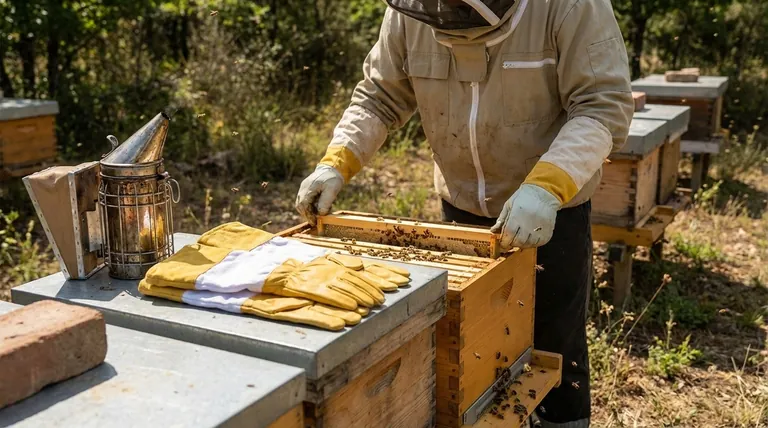In short, you must have gloves available because a bee colony's temperament is not static. A hive that was perfectly calm last week can become defensive in an instant due to weather, forage availability, or internal colony stress. Having gloves within arm's reach is non-negotiable insurance against a situation that can change without warning.
The decision to work with or without gloves isn't about being a "tough" beekeeper; it's about risk management. While going gloveless offers tactile benefits, having gloves ready acknowledges the fundamental unpredictability of honey bees and prioritizes your safety above all else.

Why a Calm Hive Can Turn Aggressive
A honey bee colony is a complex superorganism that reacts to dozens of internal and external stimuli. Understanding these triggers is key to knowing when you might need to put those gloves on.
The Impact of Weather
Bees, like many people, are sensitive to the weather. A dark, windy, or rainy day can keep foragers inside and put the entire colony on edge. A sudden drop in barometric pressure preceding a storm is a common trigger for defensive behavior.
Fluctuations in Forage
When nectar and pollen are abundant (a "nectar flow"), bees are typically busy and docile. However, during a "dearth" when resources are scarce, colonies become highly protective of their stored honey and are much more likely to see you as a threat.
The Colony's Internal State
A hive's mood is a direct reflection of its health. A colony that has recently lost its queen, is fighting off pests like Varroa mites, or is being harassed by robbers from other hives will be significantly more defensive.
The Beekeeper's Influence
Your own actions are a major factor. Accidentally bumping the hive, crushing a bee, or moving frames too quickly can release alarm pheromone, which signals to other bees that the colony is under attack. Once this chemical cascade starts, it is difficult to stop without protection.
Understanding the Trade-offs: Dexterity vs. Safety
Experienced beekeepers often prefer working without gloves, and for good reason. However, these benefits must be constantly weighed against the potential risks.
The Argument for Going Gloveless
Working barehanded provides superior dexterity and a better "feel" for the hive. You are less likely to crush bees and can manipulate frames more gently. This forces a slower, more deliberate pace, which in itself can keep the bees calmer.
The Non-Negotiable Need for Protection
The primary drawback of working gloveless is the lack of protection when things go wrong. A single sting on the hand is manageable. A coordinated defensive attack involving dozens or hundreds of bees is a serious medical risk and can make you highly sensitized to future stings.
When Gloves Are Not Optional
For certain tasks, gloves are essential. Working with a known aggressive colony, performing a "cut out" to remove bees from a structure, or handling a particularly defensive queen line are all situations where safety must be the absolute priority.
Making the Right Choice for Your Goal
Your decision to wear gloves should be made before you open each hive, based on conditions and goals. Having them available means you can always make the safe choice.
- If your primary focus is a routine inspection of a calm hive: You might start barehanded, but keep your gloves in your pocket or on the hive lid. Put them on at the first sign of increased defensiveness.
- If you are working with an unknown colony or during poor weather: Prioritize safety and start the inspection with your gloves on. You can always take them off if the bees are exceptionally calm.
- If you are performing an intrusive task like a split or requeening: Wear your gloves from the beginning, as these actions are more likely to agitate the colony.
Ultimately, having gloves available is the mark of a prepared and responsible beekeeper who respects the colony's power and unpredictability.
Summary Table:
| Situation | Risk Level | Recommended Action |
|---|---|---|
| Routine inspection, calm weather | Low | Gloves available, optional use |
| Sudden weather change, scarce forage | High | Wear gloves immediately |
| Intrusive tasks (e.g., requeening) | Very High | Always wear gloves |
Protect Your Passion with the Right Equipment
As a commercial apiary or beekeeping equipment distributor, your safety and efficiency are paramount. A single unprepared moment can lead to a serious incident. HONESTBEE supplies durable, high-dexterity beekeeping gloves and protective gear designed for professional use, helping you manage risk effectively without compromising on feel.
Contact HONESTBEE today to explore our wholesale-focused range of beekeeping supplies and equipment. Let us help you stay prepared, productive, and protected.
Visual Guide

Related Products
- Beekeeping Gloves Goatskin Leather with Long Cotton Sleeve for Beekeepers
- Goatskin Leather Beekeeper Gloves with Vent Long Sleeve for Beekeeping Honey Bee Sting Proof Protection
- Mesh Ventilated 3 Layer Goatskin Beekeepers Gloves for Beekeeping
- Goat Skin Leather Bee Sting Proof Beekeeping Gloves with Canvas Sleeve
- Professional Galvanized Hive Strap with Secure Locking Buckle for Beekeeping
People Also Ask
- What is the safest way to handle frames in beekeeping? Master Gentle Handling for a Calm Hive
- Why is dexterity and flexibility important in beekeeping gloves? Boost Your Hive Management Efficiency
- What are the advantages of goatskin leather gloves for beekeeping? Superior Sting Protection for Your Apiary
- What should beekeepers consider regarding the fit of beekeeping gloves? Achieve Safety and Dexterity
- What are the features of ventilated bee gloves? Stay Cool & Dexterous in Warm Weather



















